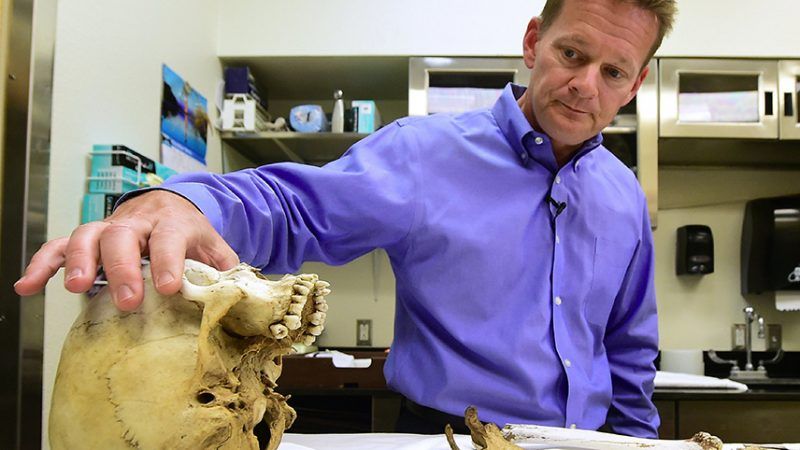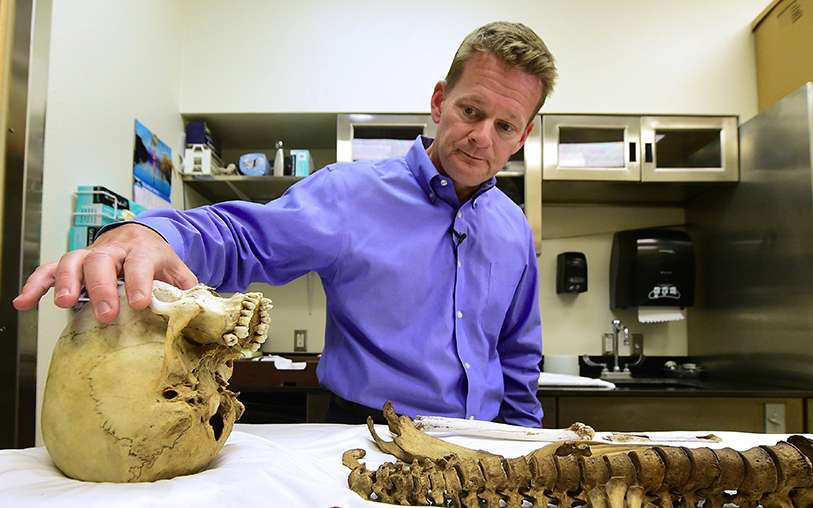The Man Who Counts Bodies in the Desert


Over the last 24 years, during four presidential administrations, enforcement on the U.S.-Mexico border has gotten much tougher. The miles of fencing grew; the number of guards exploded. While there's no evidence that "securitization" reduced illegal immigration—the number of border apprehensions of undocumented aliens did not fall dramatically until the Great Recession—it did succeed in forcing migrants to cross in less hospitable places. Pima County Chief Medical Examiner Gregory Hess says the result has been a spike in the number of people meeting lonely deaths in the deserts of Arizona. In 2000, his office began keeping detailed records of the human remains they received. In January, Reason's Christian Britschgi spoke with Hess about the specifics of his grim work.
Q: What made you start tracking these remains?
A: We just started to get more. It's really that simple. Back in the 1990s, we would average about 12 of these a year. We're talking about people that appear to have died in the active attempt of crossing into the United States without permission from the U.S. government—remains that we might find in a remote area that we believe to be a foreign national. We would examine the remains, issue a cause of death, and try to identify the person. Just by the nature of where we live and the environment we're in, sometimes that happens. But then we went from about 12 a year to 75, I think, in 2000. We averaged about 170 a year from 2002 to the end of 2013, and we had 154 last year.
Q: How do these remains find their way to your office?
A: About 50 percent are found by Border Patrol. They call whatever the local law enforcement agency is, based on where the remains are found. That local law enforcement agency will respond to the scene and do their own preliminary assessment, and then they'll call us.
Q: What do you look for when trying to determine whether this was just a lost hiker or an undocumented border crosser?
A: Property that might be with the remains, the condition of the remains, where the remains are found, whether someone is looking for a missing person, and are those remains consistent potentially with that missing person.
Q: And what is the most common cause of death?
A: The No. 1 cause of death from 2000 to 2017 was "undetermined." The reason is if the remains are decomposed, we can't definitively determine what happened. Death due to exposure—hypothermia, hyperthermia, dehydration—is the No. 2 category. But there is no specific lab test you could do to prove someone died as the result of heat stroke, for example.
Q: Given the conditions, how quickly would a body decompose to the point where you can't tell the cause of death?
A: Each case is specific to the circumstances. We have a 1-to-7 scale—1 being people who are fully flesh and in good condition, 7 being remains that are fully skeletal, weathered by the sun, and in the desert for a long period of time. It just depends.
Q: Are you able to find the identities of these folks?
A: We've been successful about 65 percent of the time. Sometimes we are able to make an identification relatively quickly and sometimes it takes a long time. And it's really circumstance-dependent—whether or not there is property found on the remains and whether or not family members are looking for that person.
Q: After you guys have gone through your process with the remains, what happens to them?
A: Unidentified remains would be interred at the county cemetery. They are buried or cremated, depending on the circumstance. And if they are identified at a future date, then they can be returned to family members.
This interview has been condensed and edited for style and clarity.
This article originally appeared in print under the headline "The Man Who Counts Bodies in the Desert."
Rent Free is a weekly newsletter from Christian Britschgi on urbanism and the fight for less regulation, more housing, more property rights, and more freedom in America's cities.



Show Comments (21)